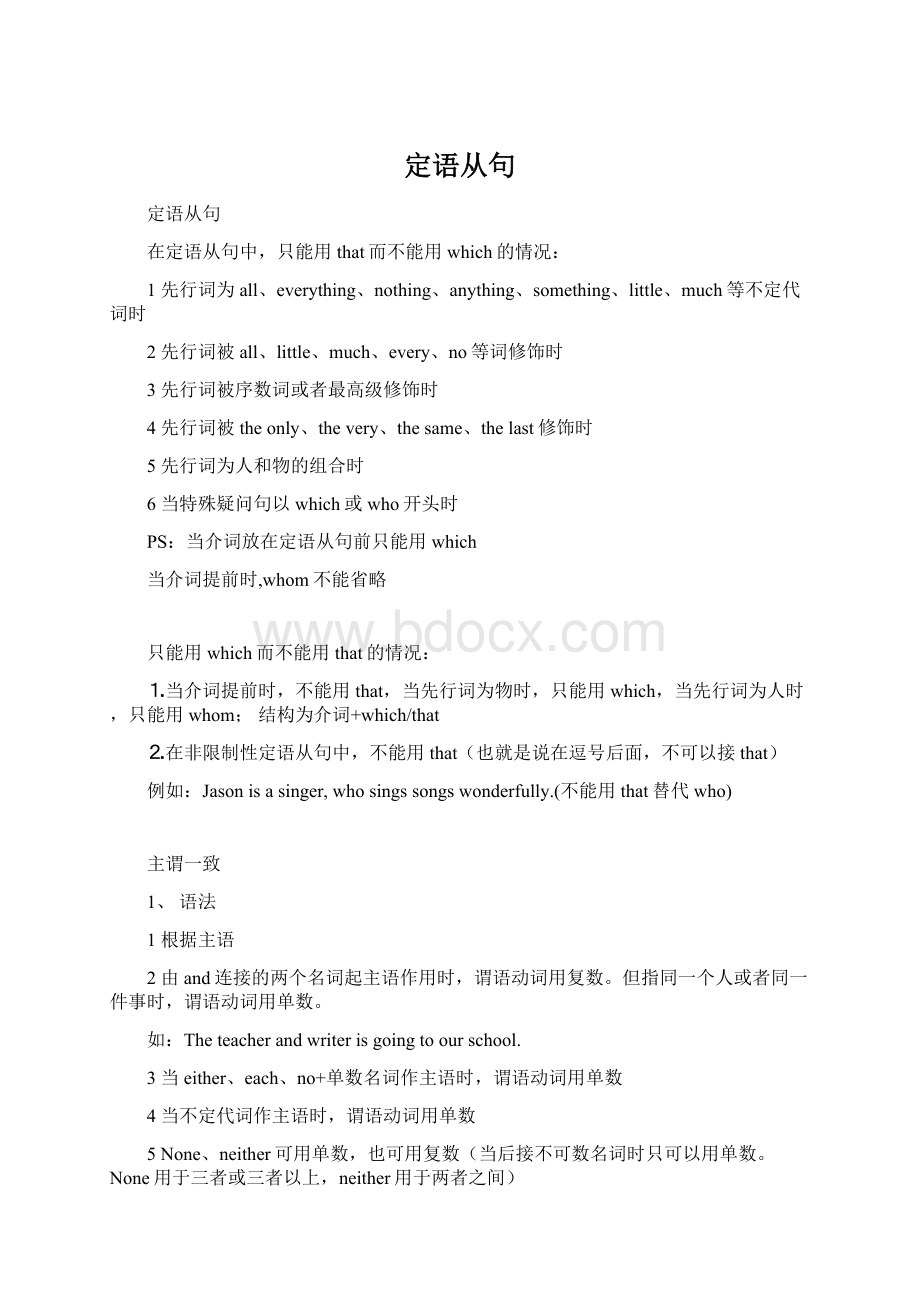定语从句Word格式文档下载.docx
《定语从句Word格式文档下载.docx》由会员分享,可在线阅读,更多相关《定语从句Word格式文档下载.docx(9页珍藏版)》请在冰豆网上搜索。

None用于三者或三者以上,neither用于两者之间)
补充:
among用于三者或三者以上,between用于两者之间,形式为between…and
2、意义
1表示金钱、时间、距离、数学算式等的名词按单数对待
2集体名词一般按单数对待,但如果强调其成员可以视为复数(如:
class、population、company、government、group、team、)
police、people、cattle本身为复词形式
3some/therestof/分数/百分比+名词要视名词所知而定
90%ofstudentsarefromBoluo.
4ing、不定式句子作主语,谓语动词用单数
3、就近一致:
either…or、neither…or、notonly…butalso、therebe结构
4、就远一致:
with、but、aswellas、expect、including
名词、数词、冠词
many、afew、few、several、anumberof、number、a、an后接可数名词
much、alittle、little、anamountof、abitof后接不可数名词
alotof、lotsof、some、any、enough、plentyof后可接可数名词,也可接不可数名词
paper、fish、room、glass、chicken、orange可以作可数名词也可以作不可数名词
不可数名词:
fun、news、weather、advice
Whatfunitistoread.Suchabook.
以f结尾的,变f为v加es
以o结尾的:
有生命的加es,如:
(英雄hero,西红柿tomato,土豆potato,黑人negro)无生命的加s
以x、ch、sh、s结尾的加es
以ese结尾的什么人,单复数同行(注意Germans、Romans)
bamboo、fish单复数同行
表示年龄:
Theboyisseven.
Heisaseven-year-oldboy.
Attheageofseven
Inone’ssevens
表示时间:
At:
8o’clock/8:
00/8am/8:
30/tenpasteight/tentoeight
(8点10分)(8点差10分)
表示度量:
基数词+量词+adj(1.7metrestall)
表示分数:
基数词(分子)+序数词(分母)当基数词≥2时,序数词加s
表示百分比:
基数词+percent
冠词
定冠词the:
①这,那②the+序数词③the+形容词最高级④独一无二的事物
⑤方位词⑥the+姓氏⑦playthe+乐器⑧the+普通名词构成的专有名词
⑨the+adj(一类)⑩the+江河湖泊
零冠词(不用冠词):
①不可数名词②年、季、月、星期、节日③科目、国名、州名④专有名词⑤具体工作部门、抽象概念⑥三餐饭⑦by+交通工具
⑧V-ing前⑨play+运动、游戏、球类⑩名词+数词(表示顺序,如:
Class5)
代词
It:
形式主语:
It+be+adj/n+todosth
形式宾语:
think/find/consider/feel/it+adj+todosth
It指代上文出现的同一名词、同一事物;
one指代上文出现的同一名词
Mybookisonthedesk.Itisred.
Yourpenlooksnice.Iwanttobuyone.
ThepopulationofChinaismuchbiggerthanthatofJapan.
Helponeselfto(请便)
Teachoneself自学
Enjoyoneself玩得愉快
Some可用于请求的疑问句当中,any用于疑问句、否定句、条件句
Wouldyoulikesomecakes?
None人/物、可数/不可数、数、noneof
Noone人
例句:
Howmanypeoplearethereintheroom?
None.
Whoareintheroom?
Noone.
Eachofushasanewbook.
Weeachhaveanewbook.
否定形式:
every、each——noboth——neitherall——nonealways——never
(every、each、both、all、always)+not表示部分否定
Ononehand,ontheother(hand)一方面,另一方面
形容词与副词
Adj+n(be/连系动词)+adj及物动词+宾语+adj
Adj(-able、-ful、-less、-y、-tive、-ed(人)、-ing(物))
Adv+(adv、adj)(不及物动词/及物动词+宾语)+adv(adv、adj)+enough
频度副词(肯定):
always、usually、often、sometimes
(否定):
seldom(很少)、never
形容词+ly——副词
Nearly=recentlynearly=almost
可以作形容词也可以作副词:
fast、late、early
程度副词:
ery、hardly、far、much、quite、rather、fairly、pretty、too、so
比较级句型:
1)比较级+than
2)比较级+and+比较词
3)The+比较级,the+比较级,表示“越……,越……”
4)The+比较+oftetwo
5)比较级+than+anyother+单数
6)比较级+than+theother+复数
介词
介词+(名词/代词/动词ing形式/从句)
时间“三姐妹”at(小时间)、in(大时间)、on(某一天)
atnoon、at6o’clock、in1996、intheevening、insummer、onMonday、onahotday、onMondaymorning、inDecember
时间的前后:
before、after
Don’tsythatbeforeyoulookatthpicture.
After4days,shecametoadeepriver.
时间的期限:
by、till、until
bythetimeIarrived,shehadalreadygone.
Iwon’tbefreetillSaturdayafternoon.
时间的期间:
for、during
Ihavebeenherefor10years.
Duringthelifetimeofoneman,itoftenhappensalotofthings.
时间的经过:
in(用于将来时)、within
Iheardthatshewouldbebackinamonth.
Inthisway,themessagewouldbesent500kmswithinafewhours.
地点和方位介词:
里面in、上面on、over、under上下方、at在某一地点、infrontof前、behind后
Inthemiddleof在中央between两者之间、among在三个或三个以上之间、around表示在四方from来自、朝向to、从中穿过through、表面跨越用across、沿着…走along
到上面onto、进里面into、在旁边用beside、在附近用nearby
其他介词:
In1)what’sthisinEnglish、
2)thegirlaswaystalksinatiredvoice.
3)theboyinajacketismybrother.
Against、for:
thepeopleinthesaltlakecityfightagainstthelocusts.
Nothing、but、except、insteadof:
1)alltheboysarehereexpectTom.
Like、as、past、about:
Ihavemanykindsofclothes,likeskirts、suits、dress.
情态动词
情态动词+doneed作情态动词时,用于疑问句或否定句中
表示规则和建议:
should、shouldn’t、must、mustn’t、haveto、can’t
表示许可:
can、could、may、might
表示能力:
can、could、beableto
表示可能:
must想必、一定80%用于肯定句
May、might有可能50%以上用于肯定/否定句
Can’t、couldn’t、can、could可能0%用于否定句、疑问句(如果用于肯定句,表示未来有可能)
请求对方做事情:
will/would/couldyou…?
Dosth,willyou?
Will/wouldyouplease…?
Wouldyoumind?
Doyoumind?
Iwonderifyoucan
命令,不得不,禁止:
must、mustn’t、haveto
没必要:
needn’t、don’thaveto
…好吗?
:
shall(用于第一人称)、will(用于第二人称)
Shall的回答是goahead.
表示推理:
must+动词原形,用于肯定的推理,表示“一定”
Can’t+动词原形,用于否定的推理,表示“不可能”
May+动词原形,表示可能的推理
Can/could+动词原形,表示可能的推理,常用于疑问句
情态动词的回答:
Can的肯定和否定回答分别用can和can’t
May的肯定和否定回答分别用“yes,please.”或“ofcourse./certainly;
“no,youmustn’t.”或“no,youcan’t.”
Must的肯定和否定回答分别用“yes,youmust.”;
“no,youneedn’t”或“no,youdon’thaveto.”
易混情态动词:
Can、beableto在一般现在时和一般过去时可以通用。
Beableto可以用于各种时态
Must只能用于一般现在时。
而haveto可以用于更多的时态。
Must侧重于“主观,不得不”
动词及时态
常见的系动词:
be、变化(turn、get、become、grow、go)、感官(feel、sound、look、smell、taste)、保持(keep、stay、remain)、系动词+adj(除固定搭配和be动词)
一般现在时的暗示词:
often、usually、sometimes、always、everyday、onceaweek
现在进行时:
暗示词:
now、atpresent(目前)、atthemoment(此刻)、thesedays(目前、现在)、look(看)、listen(听)
句型结构:
be+v-ing
一般将来时:
tomorrow、tomorrowmorning、nextyear、fromnowon、soon、inafewdays、inthefuture
shall/will+动词原形
Begoingtodo
短暂性动词的ing形式表示将来(如:
come、go、leave、arrive、open、start)
注意:
在when、until、assoonas、before、after引导的时间状语从句和if引导的条件状语从句中,从句要用一般现在时代替将来时
一般过去时:
justnow、…ago、in1982、lastmonth、theotherday、lastnight、
usedto、yesterday、attheendoflastmonth
句型:
主语+was/were+表语
主语+动词过去式+其他
过去进行时:
then(那时)、atthattime(那时候)、atthistimeyesterday(昨天这个时候)、atfiveyesterday(昨天5点)、…when、while(…的时候)
主语+was/were+doing
(注意:
当when、while开头时,短暂性词语用过去式,延续性动词用ing形式)
现在完成时:
already、yet、ever、never、for(后接一段时间)、since(后接时间点)、inthelast/pastfewdays(在过去的几天)、sofar(到目前)、just(刚刚)、twice、before
主语+have/has+过去分词
Ihaveseenthisflimalready.Isawityesterday.
Havebeento:
去了,到过,暗含又回来了
Havegoneto:
去了,暗含还没有回来,或在回来的路上
Havebeenat:
去了,并且在那里待下去
短暂性动词和延续性动词之间的转化:
Leave——beawayfrom、buy——have、borrow——keep、
Die——bedead、come/get(back)——beback、open——beopen、
Begin/start—beon、become——bearrivein(at)/getto/reach——behere/there
被动语态
好洗、好写、好卖用主动语态表示被动,(表示特征不能用被动语态)
不及物动词及连系动词不能用于被动语态(happen、takeplace、look、taste、feel、sound、smell、become)
ThePeople’sRepublicofChinawasfounded(建立)onOctober1,1949.
非谓语动词
Start/begin/continue+todo=start/bigin/continuedoingsth
Like/hate/love/prefer+todo(经常)/doing(具体某一次)
Meantodo(计划做)/doing(意思是)
Goondoingsth(继续做同一件事)/todosth.(继续做另一件事)
Trytodo(尽力)/doing(试着)
Remember/fogettodo(以后要干什么)/doing(以前做什么)
(make、let、have)+sbdosth.
(ask、tell、allow、order、invite、advise)+sb(not)todosth
(see、hear、watch、notice、find、feel、lookat、listento)+sbdo/doing
(经常)(正在进行)
Todo=inordertodo
Be+adj(表示心情的)+todosth做某事…
Enoughto(足够多)too…to…(太……而不)
(time/place/chance/way)todosth.
序数词/最高级+n+todo
(therebe/have/has)+n+todo有……要去做的
疑问词+todo=宾语从句
(haveproblem/bebusy/spendtime/havefun)+(in)doingsth
宾语从句
If引导的条件句,一般结构是主将从现。
Idon’tknowifhewillcome,ifhecomes,Iwilltellyou.
If、whether…ornot引导的是宾语从句是“是否”的意思。
语序:
陈述语序。
what’sthematterwithyou?
时态:
①前后一致,主句用过去式时,从句也用过去式。
②当是客观真理时,从句用一般过去时
③当主句为一般现在时时,从句根据句子的意思来定句子时态